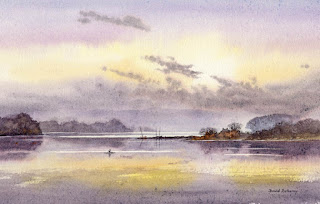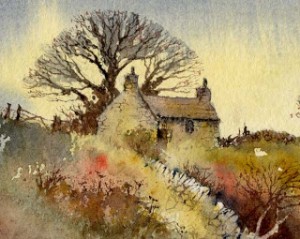We’ve just returned from Spain where we ran a group painting holiday in the lovely old Andalucian town of Ronda, based in a hotel right on the edge of those sheer cliffs. It was brilliantly organised by Richard Cartwright of West Norfolk Arts. I did several sketches of the mountain panorama from my balcony, taking care not to drop a pencil as it wouldn’t have stopped for over 200 feet straight down!
Ronda is full of fascinating subjects, apart from its magnificent Puente Neuvo, the bridge that links the two parts of the town and spans the dramatic gorge. The watercolour sketch shown on the right is of the old bridge, which I carried out with a sanguine pen and a limited range of harmonious colours to retain unity. I chose to do it fairly early in the morning when it was backlit, for added drama, but also to avoid the crowds of tourists. I could see the green fields beyond the bridge and the blue-grey mountains beyond them, but chose to introduce a misty atmosphere in which I could lose detail. This was especially helpful with the gorge itself as it enhanced the sense of space and depth, which is also true of the vertical dimension as it goes down a long way.
We were mainly blessed with good weather most of the time, although we did have a number of splendid storms, one of which was accompanied by a cloudburst that filled the streets with roaring torrents, trapping many for nearly an hour.
I last painted in Ronda many years ago when we filmed Travelling Adventures in Watercolour, a film produced by APV Films of Chipping Norton. Copies are available on our website either on its own or as a double DVD with Coastal Adventures in Waterchttp://www.apvfims.com/olour.
The mountains are not high when compared to the Pyrenees, but they are shapely and make fine compositions. One day I’ll return and enjoy rambling on them, come storm or sunshine…….






